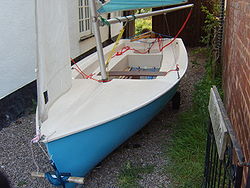Adventuress (dinghy)
| |
This article does not cite any references or sources. Please help improve this article by adding citations to reliable sources. Unsourced material may be challenged and removed. (December 2007) |
The Adventuress sailing dinghy class was designed by Ian Proctor and built by Anglo Marine of Essex. It is no longer in production.
It is not known how many were built or how many survive today, although the secondhand market occasionally sees an Adventuress changing hands.
The Adventuress is classed as a family dinghy due to its spacious design and stable hull made so by the unique bilge keels. It is ideally suited for families, or less experienced sailors, or those who want a solid, easily handled, undemanding dinghy for cruising. Although larger than both, being 12.5 foot in length, the Adventuress could be compared to a Heron or Gull (which is also built by Anglo Marine).
The dinghy is 12 feet 6 inches long with a mast just over 18 feet.
It is sailed with a Mainsail and Jib and performs very well, remaining balanced in all conditions.
Construction
An Adventuress is solidly constructed of GRP. The bilge keels are formed as an integral part of the hull, and create dynamic and directional stability - they do not contain ballast. The hull and deck mouldings are complemented by inner mouldings that create built-in buoyancy tanks at bow and stern and along each side. Originally these buoyancy tanks had no external access, although some owners will have added hatches and bungs to make these accessible for stowage and to help the hull breathe when in storage.
The unusual configuration of the bow buoyancy tank creates a generous amount of stowage space under the foredeck for paddles, buckets, fishing gear, etc.
There are no floorboards and no inner floor.
The rudder, tiller and extension are made from wood. The original design has a lifting rudder which is held in the down position by a piece of shockcord.
As these boats are now ageing somewhat, the original gelcoat may have faded or gone chalky if the boat was not kept under cover. It would not be unusual in a boat of this age for hulls to have been renovated by painting the original gelcoat.
The deck and inner mouldings have a moulded-in non-slip pattern on the decks and side benches. The inner edge of the side deck is contoured, making the boat comfortable to sit inside, and also comfortable to the backs of the legs when sitting on or hiking out over the side decks.
A marine plywood case houses the centreboard, and supports the cross-thwart - which is made from solid mahogany.
Moulded into the back is a useful locker with a marine ply hatch, which, though not watertight, is handy for holding flasks, sandwiches and knick-knacks.
The boat had no facility for rowlocks and oars. Some examples feature a mounting point for a small outboard motor adjacent to the rudder.
Rig
An aluminium mast and boom are used to set a bermuda rig of mainsail and jib. To keep things simple, the jib sheets lead to fixed fairleads and cam-cleats, the mainsail is loose-footed, and the mainsheet leads to a rope horse across the transom. ClamCleats may be present to allow this mainsheet traveller to be adjusted. The standard mainsail has three fibreglass battens, and can be shaped using a kicking strap and Cunningham.
Sailing
For its size the Adventuress is a stable dinghy, ideal for learning or relaxed family cruising, although, given enough wind, the boat will plane off the wind. The beamy hull and the small keels on the bilges give the boat a forgiving nature although, like any unballasted dinghy, it is, of course, possible to capsize it. When capsized, the boat floats high in the water (due to the generous amount of built-in buoyancy) and can be righted in the standard way by standing on the projecting centreboard.
Despite its size, because of its uncluttered cockpit and simple controls, the boat can accommodate up to four people while sailing.

